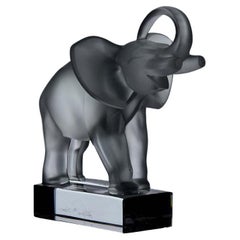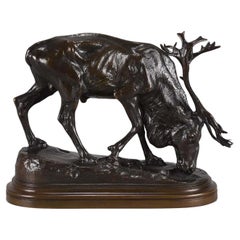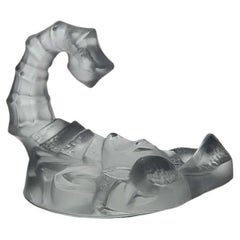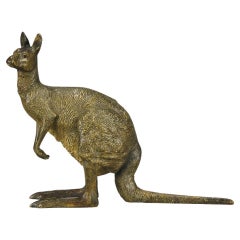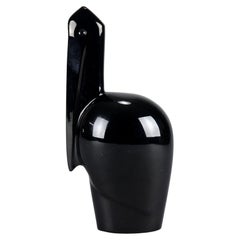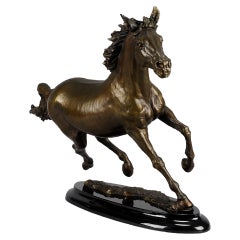Hickmet Fine Arts Animal Sculptures
to
76
10
32
44
10
26
2
6
1
2
40
21
7
4
1
62
61
24
4
2
86
79
58
14
3
3
Height
to
Width
to
86
86
86
13
12
10
5
4
20th Century Frosted Glass Sculpture Entitled "Standing Elephant" by Lalique
By Marc Lalique
Located in London, GB
Impressive Mid-20th Century clear and frosted glass figural study of an African elephant with its trunk raised. The surface with fine detail, signed Lalique France
Additional information
Height: 15 cm
Condition: Excellent Condition
circa: 1970
Materials: Clear & Frosted Glass
About
Lalique Glass
René Lalique (1860-1945) began his career as a jewellery apprentice at the age of 16, and by 1881 he was a freelance designer for many of the best-known Parisian jewellers. In 1885, he opened his own workshop on Place Gaillon in Paris, the former workshop of Jules Destape. In 1887, Lalique opened a business on Rue du Quatre-Septembre, and registered the "RL" mark the following year. In 1890, he opened a shop in the Opera District of Paris. Within a decade, Lalique was amongst the best-known Parisian jewellers.
In 1905, Lalique opened a new shop at Place Vendôme which exhibited not only jewellery, but glass works as well. It was close to the shop of renowned perfumer François Coty; in 1907, Lalique began producing ornate perfume bottles for Coty. The production of glass objects began at his country villa in 1902, and continued there until at least 1912. The first Lalique glassworks opened in 1909 in a rented facility in Combs-la-Ville, which Lalique later purchased in 1913. In December 1912, Lalique hosted an exhibition of Lalique Glass—as his glass would come to be known—at the Place Vendôme shop. During the First World War, the glassworks produced mundane items in support of the war effort. In 1919, work began on a new production facility in Wingen-sur-Moder, which opened in 1921. From 1925-1931, Lalique produced 29 models of hood ornaments; a mermaid statuette first produced in 1920 was also later sold as a hood ornament. During the 1920s and 1930s, Lalique was amongst the world's most renowned glassmakers.
René Lalique died in 1945. His son Marc Lalique took over the business, operating initially as "M.Lalique" and later as "Cristal Lalique...
Category
20th Century French Art Deco Animal Sculptures
Materials
Glass
19th Century Animalier Bronze Sculpture Entitled "Reindeer" by Isidore Bonheur
By Isidore Jules Bonheur
Located in London, GB
Excellent late 19th century animalier bronze study of a feeding reindeer with rich brown colour and very fine hand chased and etched surface detail, raised on a stepped naturalistic base, stamped with Peyrol Foundry mark and signed Isidore Bonheur
Additional information
Height: 16 cm
Width: 22 cm
Condition: Excellent Original Condition
Foundry: Peyrol
circa: 1880
Materials: Bronze
SKU: 8211
DESCRIPTION
Isidore Bonheur
Isidore Bonheur, born in Bordeaux May 15 1827. Isidore was the third child of Christine Dorotheé Sophie Marquis (1797–1833), a musician, and Oscar-Raymond Bonheur (1796–1849) (a landscape and portrait painter and an early adherent of Saint-Simonianism, a Christian-socialist sect that promoted the education of women alongside men). Isidore was the brother of Auguste Bonheur...
Category
Antique Late 19th Century French Art Nouveau Animal Sculptures
Materials
Bronze
Mid-20th Century Frosted Glass Scorpion by Marc Lalique
By Marc Lalique
Located in London, GB
A surprising frosted glass figure of a scorpion with its tail raised, ready to strike its prey. The frosted glass surface with excellent hand finished detail, signed Lalique France
Additional information
Measures: Height: 7 cm
Condition: Excellent Condition
circa: 1950
Materials: Hand Finished Frosted Glass
SKU: 6008
DESCRIPTION
The Scorpion...
Category
20th Century French Art Deco Animal Sculptures
Materials
Glass
Early 20th Century Cold-Painted Bronze Entitled "Kangaroo" by Franz Bergman
By Franz Bergmann
Located in London, GB
An excellent early 20th century Austrian bronze study of a standing Kangaroo with very fine hand chased surface detail and good naturalistic colour, signed with the Bergman 'B' in an Amphora vase
ADDITIONAL INFORMATION
Height: 15 cm
Width: 20 cm
Depth: 6 cm
Condition: Excellent Original Condition
circa: 1900
Materials: Cold Painted Bronze
Book Ref Antique Vienna Bronzes by Joseph Zobel
SKU: 8910
ABOUT
Bergman Kangaroo
Franz Bergman Sculptures
Bergman is celebrated for his great attention to detail and wonderful vibrant colours, Franz Xavier Bergman (1861-1936) is, arguably, the most famous of the Viennese cold-painted bronze artists, delighting in producing Oriental...
Category
Early 20th Century Austrian Edwardian Animal Sculptures
Materials
Bronze
20th Century Art Deco Coloured Glass Sculpture Entitled "Pelican" by Baccarat
By Baccarat
Located in London, GB
A striking black glass study modelled as an Art Deco stylised pelican with very fine smooth tactile surface, signed Baccarat France.
Additional information
Height: 16 cm
Conditio...
Category
Mid-20th Century French Art Deco Animal Sculptures
Materials
Glass, Art Glass
Limited Edition Bronze Sculpture Entitled "Turning Arab" by Steve Winterburn
By Steve Winterburn
Located in London, GB
A very well modelled study of an Arab horse in full motion turning to his right, the bronze with good rich brown colour and fine hand chased detail, raised on a stepped oval black marble base, signed S Winterburn and numbered 1 of 6
ADDITIONAL INFORMATION
height: 41 cm
width: 52 cm
Condition: As New Condition
Circa: 2010
Materials: bronze & marble
SKU: 7631
ABOUT
Steve Winterburn
Steve Winterburn (born 1959, Coventry) is a self-taught artist whose creative development has been fuelled by his conviction, immense energy and curiosity. Possessing an innate comprehension of engineering and design enables him to explore his passion for challenge and experimentation.
Steve began teaching himself to sculpt in 1994. With the progression of his sculpting an ambition emerged to personally shape each piece of his work from concept
to completion. He had entrusted the casting of his earlier bronzes to the established foundries. But the delays in delivering his work became frustrating
and he was disillusioned by the changes that resulted from not handling the finishing stages himself.
In 2002 Steve moved to Yorkshire, in the north of England, and began converting the vast workshop next to his house into the current 9 room studio & foundry.
It was here he started to experiment in order to gain an understanding of the entire process that is traditionally a closely guarded secret handed down between
foundry men. The challenges included mastering mould making skills and the lost wax impression of the moulds from which a one off ceramic mould is made
ready for the bronze pouring. Expanding his expertise with chasing the bronze, his ability to hand work the malleable surface and with the patina (colours).
These stages are normally undertaken by a succession of different people, each skilled in their particular phase of the evolving sculpture. Involvement with a diversity of initiatives has taken Steve to India, Peru, Kenya, Tanzania, Rwanda, Australia and Ethiopia, sculpting people and animals.
Steve has regularly exhibited with Hickmet Fine Arts at the internationally acclaimed LAPADA Fine Art and Antiques Fairs ( the highly prestigious UK Antiques Federation) and twice with The Wildlife Arts Society at the Westminster Gallery where in 1998 he won the award for best 3 dimensional piece. He has exhibited twice at the Royal Academy in London.
Projects include developing designs for two statues...
Category
21st Century and Contemporary English Animal Sculptures
Materials
Bronze
"Djinn Étlalon Barbe" 19th Century Animalier Bronze by P J Mêne
By Pierre Jules Mêne
Located in London, GB
A very fine French Animaliers bronze study of a stallion standing behind a post and rail fence exhibiting excellent hand finished surface detail and good...
Category
Antique 1850s French Other Animal Sculptures
Materials
Bronze
Animalier Bronze Sculpture Entitled "Bear and Rabbit" by Charles Paillet
By Charles Paillet
Located in London, GB
An amusing early 20th Century bronze group of a bear peering over the edge of a rock at a rabbit quietly hiding under a ledge, with excellent rich brown patina and fine hand chased surface detail. Signed Paillet
ADditional information
Measures: Height: 18 cm.
Condition: Excellent Original Condition.
circa: 1910.
Materials: Patinated Bronze.
ABOUT
Charles Paillet
Charles Paillet (French, 1871 ~ 1937) Paillet studied sculpture under Georges Gardet. Paillet’s first exhibit was in the Salon of 1897 and he exhibited regularly until 1921. Most of his works were cast by the foundry Thiebault Freres both in lost wax and by the sand-cast method. A few of his works have been recorded bearing the F. Barbedienne foundry mark also. Charles Paillet, Georges Gardet, Rene Paris...
Category
Early 20th Century French Art Deco Animal Sculptures
Materials
Bronze
Cold-Painted Bronze Sculpture entitled "Eagle with Outspread Wings" by Bergman
By Franz Bergmann
Located in London, GB
A very fine early 20th Century cold painted Austrian bronze study of an eagle spreading its wings. The sculpture balances naturally on the talons of the eagle, free standing this a marvellous representation for these free and noble creatures. The bronze surface has excellent colour and very fine hand finished detail, signed with the Bergman 'B' in an amphora vase.
ADDITIONAL INFORMATION
Height: 9 cm
Width: 17 cm
Length: 9 cm
Condition: Excellent Original Condition
Circa: 1900
Materials: Cold Painted Bronze
Book Ref Antique Vienna Bronzes by Joseph Zobel
SKU: 8757
ABOUT
Bergman Eagle
Franz Bergman Sculptures
Bergman Eagle – Bergman is celebrated for his great attention to detail and wonderful vibrant colours, Franz Xavier Bergman (1861-1936) is, arguably, the most famous of the Viennese cold-painted bronze artists, delighting in producing Oriental, Arab bronze...
Category
Early 20th Century Austrian Art Deco Animal Sculptures
Materials
Bronze
Early Cold-Painted Vienna Bronze Sculpture entitled "Leaping Salmon"
Located in London, GB
Very fine cold painted Austrian Bronze study of a salmon leaping from the water. The bronze with excellent cold painted colours and very fine hand chased surface detail, raised on a shaped onyx plinth
ADDITIONAL INFORMATION
Height: 10 cm
Width: 13 cm
Condition: Excellent Original Condition with light surface wear
Circa: 1900
Materials: Cold Painted Bronze and Onyx
ABOUT
Vienna Bronze Leaping Salmon...
Category
Early 20th Century Austrian Art Deco Animal Sculptures
Materials
Onyx, Bronze
Animalier Bronze Sculpture Entitled "Trois Chiots" by Georges Vacossin
By Georg Vacossin
Located in London, GB
A charming early 20th century animalier gilt bronze group of three seated puppies fascinated by an approaching snail. The bronze with fine hand chased surface detail and good colour,...
Category
Early 20th Century French Art Nouveau Animal Sculptures
Materials
Bronze
"Serpent Vide Poche" by Daum Glass
By Daum
Located in London, GB
Entrancing mid 20th Century French pate-de-verre vide-poche decorated with variegated colours of greens and browns with a raised figure of a snake exhibiting fine translucent colour ...
Category
20th Century French Art Nouveau Animal Sculptures
Materials
Glass
19th Century Animalier French Bronze Entitled "Taureau Debout" by Rosa Bonheur
By Rosa Bonheur
Located in London, GB
"Taureau Debout" by Rosa Bonheur.
An excellent late 19th Century French animalier bronze study of a standing bull with fine hand chased surface that accentuates the muscle definition of the subject, signed Rosa B.
ADDITIONAL INFORMATION
Measures: Width: 32 cm
Height: 18 cm
Depth: 11cm
Condition: Excellent Original Condition
Circa: 1870
Materials: Bronze
Book reference: Animals in Bronze by Christopher Payne
Page no. 174
DESCRIPTION
Bonheur, Rosa (1822-1899)
The most popular artist of nineteenth-century France, Rosa Bonheur was also one of the first renowned painters of animals and the first woman awarded the Grand Cross by the French Legion of Honor. A professional artist with a successful career, Bonheur lived in two consecutive committed relationships with women.
Born on March 16, 1822 in Bordeaux, Marie Rosalie Bonheur was the oldest of the four children of Raimond Oscar Bonheur (1796-1849) and Sophie Marquis. Bonheur's father was an art teacher who came from a poor family, while her mother, a musician, had descended from a middle-class family and had been her husband's art student.
Bonheur's father, who taught drawing and landscape painting, was an ardent member of the utopian Saint Simeon society.
The group held idealistic beliefs about the reform of work, property, marriage, and the role of women in society. Most importantly, for the artist's future, the Saint Simeons questioned traditional gender norms and firmly believed in the equality of women. While teaching artistic techniques to his oldest daughter, Raimond Bonheur also encouraged her independence and taught her to consider art as a career.
In 1828 Raimond Bonheur joined the Saint Simeons at their retreat outside Paris. Sophie and the children joined him in Paris the following year. Four years later, however, Raimond abandoned his family to live in isolation with his fellow Saint Simeons.
Sophie Bonheur died in 1833 at the age of thirty-six. Rosa was only eleven years old when her mother died, but she was aware of the heavy price her mother paid for married life with a man who was more dedicated to his own ideals than to meeting his family's needs. Rosa also saw that her mother's marriage led to poverty and her death from exhaustion.
After her mother's death, Bonheur was taken in by the Micas family who resided nearby. Mme Micas and Bonheur's mother had been friends. When Mme Bonheur died, the Micas family paid Raimond Bonheur's debts and cared for Rosa. Their daughther, Nathalie, who would later become an amateur inventor and unschooled veterinarian, and Rosa became enamored with each other.
When Rosa Bonheur began her career as a professional artist, she had already been trained by her father who had allowed her to study in all male classes. Rosa also learned by sketching masterworks at the Louvre from the age of fourteen, and later, by studying with Léon Cogniet.
From the very beginning, Bonheur's favorite subject was animals. She learned their anatomy completely by dissecting them in local slaughterhouses. She also visited the horse market two times a week. Study of animals by direct observation led to the formation of the realist style in which Bonheur worked.
It was for such work that Bonheur obtained written permission from the French government to wear men's slacks. Her working attire also consisted of a loose smock and heavy boots that protected her feet from the dangerous environment in which she painted. The style of dress that the artist adopted for work and home may well have been influenced by her father's attire, which was based on St. Simeonian clothing experiments. Bonheur also cropped her hair, perhaps to facilitate her work. She did, however, always wear dresses for social occasions because she knew that appropriate dress would further her career.
Bonheur earned a successful living as a painter of animals. She exhibited at the annual Paris Salon regularly from the age of nineteen in 1841 through 1853, when she was thirty-one. She won the salon's gold medal at the age of twenty-six in 1848 and was commissioned by the French government to paint Plowing on the Nivernais in 1849. In the same year Bonheur and her sister Juliette became directors of l'École gratuite de dessin pour les jeunes filles, a post their father had once held.
Bonheur completed her most renowned work, The Horse Fair, in 1855. The successful representation of percherons (a breed native to Normandy) was purchased by Ernest Gambart, a London art dealer whose gallery specialized in work by French artists. He exhibited The Horse Fair in London where Bonheur visited with Nathalie. Queen Victoria requested a private viewing of the painting at Windsor Castle. It would later be purchased in 1887 by Cornelius Vanderbilt and donated to the new Metropolitan Museum of Art in New York City.
Bonheur's trip to England allowed her to meet Charles Eastlake, then President of the Royal Academy, John Ruskin, the English writer and critic, and Edwin Landseer, the British animalier. She also toured the English and Scottish countrysides and executed some paintings based on her observations of new breeds of animals found there.
Gambart made engravings of Bonheur's work, including The Horse Fair, and sold them in England, Europe, and the United States. Bonheur became one of the most renowned painters of the time. Little girls, such as Anna Klumpke in the United States, even had dolls in her likeness, much as American girls played with Shirley Temple dolls...
Category
Antique 19th Century French Art Nouveau Animal Sculptures
Materials
Bronze
French Animalier Bronze Study Entitled 'Chien et Pigeon' by Pierre Jules Mêne
By Pierre Jules Mêne
Located in London, GB
Excellent quality and very rare mid-19th century French Animalier bronze study of a seated griffon hound looking intently at two pigeons feeding beside him. The bronze with excellent...
Category
Antique 1870s French Other Animal Sculptures
Materials
Bronze
“Standing Setter” French Animaliers Bronze by Jules Moigniez, circa 1870
Located in London, GB
Very fine mid-19th century French Animalier bronze study of a standing Setter with excellent hand chased surface detail and rich brown patination. Raised on a stepped naturalistic base, signed J Moigniez.
Additional information:
Height: 19 cm
Width: 34 cm
Condition: excellent original condition
Circa: 1870
Materials: bronze
Book reference: Les Animaliers by Jane Horswell
Page no. 237
About
Jules Moigniez (French, 1835 ~ 1894) Moigniez was a French animalier sculptor of the 19th century. He worked primarily in bronze and frequently exhibited his sculptures at the Paris salon. He was best known for his bronzes depicting birds, although his skill and versatility enabled him to produce quality horse sculptures (primarily racehorses), dog sculptures and hunting scenes. His bird sculptures were among the finest ever created in his time. Moigniez was born at Senlis, Oise, France in 1835, the son of a metal gilder. Moigniez’s father bought a foundry to cast his sculptures, which was of great benefit to Moigniez as he didn’t have the added foundry costs that most of his contemporaries had to pay. Moigniez studied sculpture under the tutelage of Paul Comoléra (a student of François Rude) in Paris. It is quite likely that Moigniez’s attraction to bird sculpture was a direct result of his education under Comoléra, who was himself a bird specialist. Over the course of his 40-year sculpting career Moigniez exhibited thirty works at the Salon between 1855–92. His first submission in a major art exhibition was his plaster, Pointer Stopping at a Pheasant, at the Exposition Universelle of 1855.[1][2] Moigniez was known for the fine detail and chiseling of his sculptures. His bronzes—usually cast using the lost wax method—were always immaculately chased and patinated, and were especially popular in England and Scotland.[2] More than half of his output during his lifetime was sold in the United Kingdom. By the end of the 19th century, his sculpture had become popular in the United States as well. In contrast with other animaliers of the period such are P.J. Mêne and Antoine-Louis Barye, Moigniez’s bird sculptures often incorporated highly detailed bases complete with bushes, extensive foliage and undergrowth. His castings were generally of excellent quality with a variety of patinas, the gilded and silvered patinas being the most desirable and sought after by collectors. His bronzes could be reproached for an excess of detail, a result of overly-finicky, over-worked chiseling. Moigniez received redemption, however, by portraying in his sculpture a certain “elegance of attitudes”. His Chien braque...
Category
Antique 19th Century Animal Sculptures
Materials
Bronze
Early-20th Century Animalier Bronze Entitled "Seated Alsatian" by Louis Riché
By Louis Riché
Located in London, GB
A striking French Animalier gilt and patina tied bronze study of a seated Alsatian in alert pose with head turned slightly and ears pricked. The surface with excellent naturalistic detail and very fine colour, signed L.Riché and stamped with foundry seal for Thiebaut Frères
Additional information
Height: 50 cm
Width: 46 cm
Condition: excellent original condition
Foundry: Thiebaut Frères
Circa: 1910
Materials: Bronze
SKU: 7528
ABOUT
Louis Riché Bronze...
Category
Vintage 1910s French Art Nouveau Animal Sculptures
Materials
Bronze
20th Century Animalier "Resting Owl" by H Sieloff
Located in London, GB
An endearing early 20th century bronze study of an owl perched upon a branch with excellent colour and very fine smooth tactile surface, signed and dated 1921
Additional information...
Category
20th Century German Art Nouveau Animal Sculptures
Materials
Bronze
Early-20th Century Animaliers Bronze Entitled "Two Alsatians" by Louis Riché
Located in London, GB
A fabulous French Animalier gilt bronze group of two Alsatians, one seated in alert pose with its head turned slightly and ears pricked whilst the other one lays in an alert pose. The surface with excellent naturalistic detail and very fine colour, signed L.Riché and stamped with foundry seal for Thiebaut Frères
Additional Information
Height: 32 cm
Width: 38 cm
Condition: Excellent Original Condition
Foundry: Thiebaut Frères
Circa: 1900
Materials: Bronze
About
Louis Riché Bronze...
Category
Antique Early 1900s Animal Sculptures
Materials
Bronze
Anamilier Bronze Entitled "Greyhound and King Charles Spaniel" by P J Mêne
By Pierre Jules Mêne
Located in London, GB
Delightful mid 19th Century French Animaliers bronze study of a playful Greyhound and King Charles Spaniel, with rich brown rubbed to a golden colour and fine hand chased surface det...
Category
Antique 1870s Art Nouveau Animal Sculptures
Materials
Bronze
Late-19th Century French Animalier Bronze Entitled "Turning Whippet" by L Mayer
By Louis Mayer
Located in London, GB
Delightful late19th century French Animaliers bronze study of a turning whippet looking around in an attitude to play, with rich brown colour and fine hand chased surface detail. Sig...
Category
Antique 19th Century French Art Nouveau Animal Sculptures
Materials
Marble, Griotte Marble, Bronze
Mid-19th Century French Bronze Entitled "Old Man Odry" by Christophe Fratin
By Christophe Fratin
Located in London, GB
Exquisite mid 19th century French bronze study of an anthropomorphic bear sitting on a barrel playing a violin, the barrel can be opened halfway to form a container. The surface with excellent mid to dark brown patina and very fine hand chased surface detail, signed Fratin and titled Le Père Odry
Additional Information
Height: 17.8 cm
Width: 8.6 cm
Depth: 7.2 cm
Condition: Excellent Original Condition
Circa: 1845
Materials: Bronze
Book reference: Bronzes of the 19th Century by Pierre Kjellberg
About
Le Père Odry
Le Père Odry is a character in one of Balzac's novels, Unconscious Comedians which is one of the lesser known novels in the series La Comédie Humaine. The novel tells the story of a famous painter who takes his provincial cousin on a trip of Paris to open his eyes to what really goes on in the city behind the respectable façade. Le Père Odry appears in the novel as a dissolute actor.
Christopher Fratin, French 1801 ~ 1864
also known as Christophe Fratin, was a noted French sculptor in the animalier style, and one of the earliest French sculptors to portray animals in bronze. Fratin was born in Metz, Moselle, France the son of a taxidermist. He first studied drawing under Pioche in Metz and later worked in Paris at the studio of Théodore Géricault.
He exhibited at the Paris Salon from 1831–1842 and 1850–1862, as well as at the Great Exhibition in London in 1851. Fratin never signed his bronzes but instead used a stamp showing his last name in straight block letters. One of the stamps he used (pictured) showed the "n" reversed, not by design but due to an error on the part of the maker of the stamp. Bronzes bearing this stamp have the appearance of not seeming to be genuine when in reality this foible is actually an indicator of authenticity.
Fratin received monumental commissions in France and elsewhere, including the Deux Aigles Gardant Leur Proie (Eagles and Prey, created 1850) displayed since 1863 in New York City's Central Park. Many of his small bronzes—including his miniature bronzes which were more affordable due to their smaller size—were sold commercially to the general public during his lifetime. Today, Fratin's sculpture is on permanent display in the Louvre, the city museums of Metz, Lyon, Strasbourg, Nîmes and at the Peabody Institute in Baltimore, Maryland. The Georg Eisler...
Category
Antique 19th Century French Art Nouveau Animal Sculptures
Materials
Bronze
19th Century Anamilier Bronze Entitled "Ewe And Lamb" by Pierre Jules Mêne
By Pierre Jules Mêne
Located in London, GB
Wonderful 19th Century animalier bronze group of a standing ewe with her feeding lamb beneath her, the bronze with excellent rich brown patina and very fine hand chased surface detai...
Category
Antique 1870s Art Nouveau Animal Sculptures
Materials
Bronze
Early 20th Century Bronze Sculpture Entitled "Lion qui Marche" by J Descomps
By Joe Descomps Cormier
Located in London, GB
A large and impressive early 20th Century bronze study of a walking lion with fine deep brown, gold and orange patination and good surface detail. Raised on naturalistic bronze base,...
Category
Vintage 1910s French Art Nouveau Animal Sculptures
Materials
Bronze
"Djinn" by P J Mêne
By Pierre Jules Mêne
Located in London, GB
A very fine French Animaliers bronze study of a stallion standing behind a post and rail fence exhibiting excellent hand finished surface detail and good...
Category
Antique Mid-19th Century French Art Nouveau Animal Sculptures
Materials
Bronze
$4,116
“Standing Hen” Vienna Bronze by Franz Bergman, circa 1900
By Franz Bergmann
Located in London, GB
“Standing Hen” Vienna bronze by Franz Bergman - circa 1900.
A very fine early 20th century cold painted Austrian bronze study of a standing hen with excellent hand chased surface detail and fine naturalistic colour, signed with the Bergman ‘B’ in an amphora vase
Franz Bergman - Austrian, 1861 - 1936 - is celebrated for his great attention to detail and wonderful vibrant colours, Franz Xavier Bergman is, arguably, the most famous of the Viennese cold-painted bronze artists, delighting in producing Oriental, Arab bronze...
Category
20th Century Austrian Animal Sculptures
Materials
Bronze
Animalier French Bronze 'Pheasant & Weasel' by Jules Moigniez
By Jules Moigniez
Located in London, GB
A large and impressive late 19th century French animalier bronze group of a Pheasant surprised by a weasel, both animals heightened with original gilding and raised on a naturalistic...
Category
Antique 1870s French Other Animal Sculptures
Materials
Bronze
